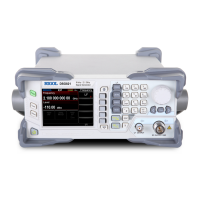Chapter 4 Application Examples RIGOL
DSG800 User's Guide 4-5
To Output a RF Modulated Signal
This section introduces how to output an AM modulated signal by taking amplitude
modulation (AM) as an example. Set the carrier frequency to 800 MHz, the carrier
amplitude to -20 dBm, the AM modulation depth to 60% and the modulation
frequency to 20 kHz.
1. Restore to the factory setting
Press Syst Reset Preset Type "Factory" and then press Preset to
restore the instrument to the factory setting (by default, the modulation source
is internal and the modulation waveform is sine).
2. Set the carrier frequency and amplitude
(1) Carrier Frequency
Press FREQ, use the numeric keyboard to input the frequency value (800)
and select the desired unit (MHz) from the pop-up unit menu.
(2) Carrier Amplitude
Press LEVEL, use the numeric keyboard to input the amplitude value (-20)
and select the desired unit (dBm) from the pop-up unit menu.
3. Set the AM modulation parameters
(1) Press MOD AM to enter the amplitude modulation parameter setting
menu.
(2) Press Depth, use the numeric keyboard to input the value of the
modulation depth (60) and select the desired unit (%) from the pop-up unit
menu.
(3) Press Freq, use the numeric keyboard to input the frequency value (20)
and select the desired unit (kHz) from the pop-up unit menu.
(4) Press Switch and select "On" to turn on the AM function.
4. Turn on the RF modulation output
Press Mod/on and the backlight is illuminated. Then, press RF/on and the
backlight is illuminated. The MOD, AM and RF labels in the function status area
in the user interface are illuminated. At this point, the RF modulation output is
turned on and the [RF OUTPUT 50Ω] connector outputs RF modulated signal
according to the current configuration.
Note: The backlights of RF/on and Mod/on must be both illuminated.
w ww. . com
information@itm.com1.800.561.8187

